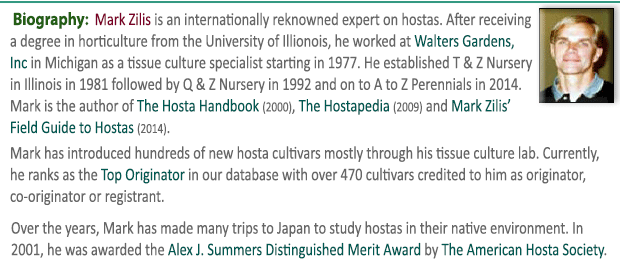|
 This species is native to Honshu
Island in
Japan. It is also known as
Mizu Gibōshi and Saji Gibōshi in
Japanese. This species is native to Honshu
Island in
Japan. It is also known as
Mizu Gibōshi and Saji Gibōshi in
Japanese.
 The plant forms a small size
(9 inches high by 25 inches wide) mound
with narrow foliage which has a shiny on top
and bottom. The
dark green leaves
are narrowly elliptic (strap shaped), smooth textured without waves. It has
average substance. Flowers are medium purple in color with
purple anthers and are borne from mid-September to October followed by viable
seeds. The plant forms a small size
(9 inches high by 25 inches wide) mound
with narrow foliage which has a shiny on top
and bottom. The
dark green leaves
are narrowly elliptic (strap shaped), smooth textured without waves. It has
average substance. Flowers are medium purple in color with
purple anthers and are borne from mid-September to October followed by viable
seeds.
 According to
The Hostapedia by Mark Zilis (2009), "...useful as a ground cover or edging plant. The
late-season flowers are in bloom at a time when the shade garden
is turning to fall in the northern U.S." According to
The Hostapedia by Mark Zilis (2009), "...useful as a ground cover or edging plant. The
late-season flowers are in bloom at a time when the shade garden
is turning to fall in the northern U.S."
The New Encyclopedia of Hostas by
Diana
Grenfell (2009) states: "Can be grown in garden ponds successfully if the
crown is kept above the water line. Is often confused with the narrowest-leaf
forms of H. sieboldii... Strap-shaped
leaves are among the narrowest in the genus."
Mark Zilis' Field Guide to Hostas (2014)
states that this species was found in Japan in "...wetlands..."
Mikiko Lockwood in an article on The Hosta Library titled,
A Little About Japanese Hosta Terms defines the term mizu as water, 'Mizu Gibōshi' or
H. longissima.

 An article by
Hajime
Sugata of Japan in
The
Hosta Journal (1994 Vol. 25 No. 2) states that "H.
longissima can be found abundantly near wetlands on sunny
hills or along irrigation paths of rice paddies in Aichi Pref.
and Gifu Pref. H. longissima grows densely and appears
smaller but healthier on the sunny side of hills as opposed to
the shady side. Thus, H. longissima can look like two
different species. An article by
Hajime
Sugata of Japan in
The
Hosta Journal (1994 Vol. 25 No. 2) states that "H.
longissima can be found abundantly near wetlands on sunny
hills or along irrigation paths of rice paddies in Aichi Pref.
and Gifu Pref. H. longissima grows densely and appears
smaller but healthier on the sunny side of hills as opposed to
the shady side. Thus, H. longissima can look like two
different species.
There aren't many regionally modified forms of H. longissima,
but a yellow-margined form and a white-margined form are found
in Okazaki City, Nukata Town, and Shimoyama Village. A gold-leaf
form has not yet been found."
|
 |
 |
|
|
"Another
late-flowering species which has been
around for years. It is well known and
needs to be grown more. It has
beautiful, dark striped (Type C) lobes
and conspicuous green bracts. Its leaves
are unique and a mature specimen makes a
showing in the garden. Most nurseries
have it for around $6.00." |
|



 |



